- PRESS RELEASE
ECB publishes supervisory banking statistics on significant institutions for the fourth quarter of 2023
10 April 2024
- Aggregate Common Equity Tier 1 ratio at 15.73% in fourth quarter of 2023 (compared with 15.61% in previous quarter and 15.39% in fourth quarter of 2022)
- Aggregated annualised return on equity at 9.31% in fourth quarter of 2023 (compared with 10.01% in third quarter and 7.68% in fourth quarter of 2022)
- Aggregate non-performing loans ratio (excluding cash balances) stable at 2.30% (compared with 2.27% in previous quarter)
- Statistics include breakdown of non-performing loans ratios by counterparty sector for first time
- Share of loans showing significant increase in credit risk (stage 2 loans) rose to 9.74% (up from 9.29% in previous quarter)
Capital adequacy
The aggregate capital ratios of significant institutions (i.e. those banks that are supervised directly by the ECB) were almost unchanged in the fourth quarter of 2023. The aggregate Common Equity Tier 1 (CET1) ratio stood at 15.73%, the aggregate Tier 1 ratio stood at 17.10% and the aggregate total capital ratio stood at 19.71%. Aggregate CET1 ratios at country level ranged from 12.67% in Spain to 21.54% in Estonia. Across Single Supervisory Mechanism (SSM) business model categories, global systemically important banks (G-SIBs) reported the lowest aggregate CET1 ratio (14.30%).
Chart 1
Capital ratios and their components
(EUR billions; percentages)
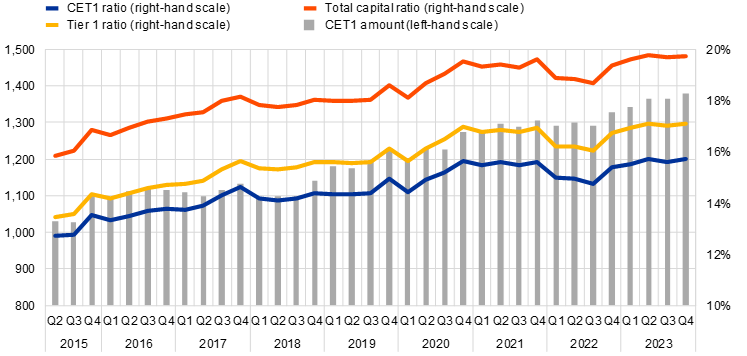
Source: ECB.
Note: “CET1” stands for “Common Equity Tier 1”.
Chart 2
Capital ratios by country for the fourth quarter of 2023
(percentages)
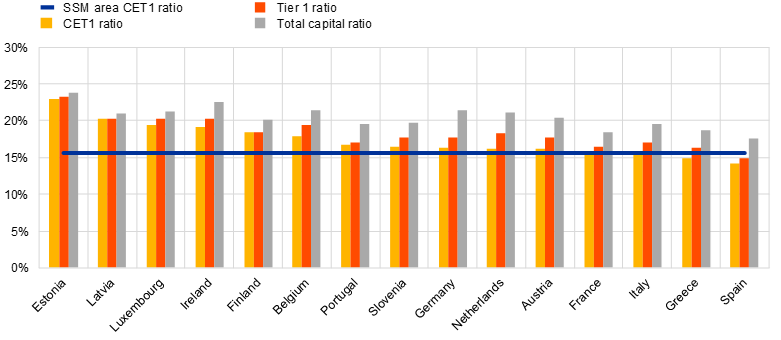
Source: ECB.
Notes: “SSM” stands for “Single Supervisory Mechanism” and “CET1” stands for “Common Equity Tier 1”. Some countries participating in European banking supervision are not included in this chart, either for confidentiality reasons or because there are no significant institutions at the highest level of consolidation in that country.
Chart 3
Capital ratios by business model for the fourth quarter of 2023
(percentages)
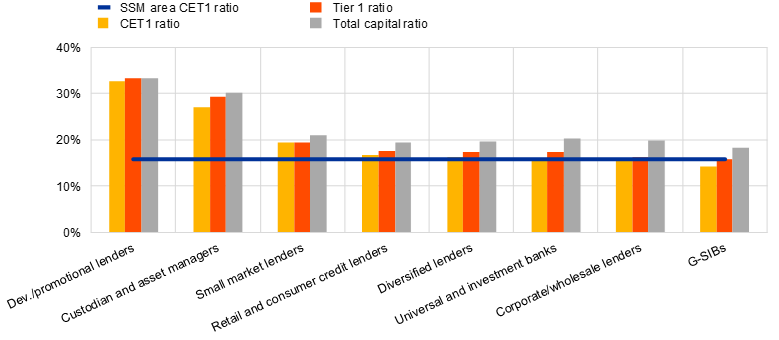
Source: ECB.
Notes: “G-SIBs” stands for “global systemically important banks”. “Dev./promotional lenders” stands for “development/promotional lenders”. “SSM” stands for “Single Supervisory Mechanism”. “CET1” stands for “Common Equity Tier 1”.
Asset quality
The non-performing loans (NPL) ratio excluding cash balances at central banks and other demand deposits remained stable, standing at 2.30% in the fourth quarter of 2023. The stock of NPLs (numerator) was almost unchanged at €347 billion, while the total of loans and advances excluding cash balances (denominator) decreased to €15,072 billion (compared with €15,183 billion in the third quarter of 2023).
Supervisory banking statistics will henceforth include a breakdown of NPL ratios by counterparty sector. In the fourth quarter of 2023 the share of non-performing loans to total loans exhibited heterogeneous dynamics at sector level, ranging from 3.48% for loans to non-financial corporations (NFCs) to 0.70% for loans to other financial corporations (OFCs), while the ratio stood at 2.19% for loans to households.
Cost of risk was stable, standing at an aggregate level of 0.46% in the fourth quarter of 2023 (compared with 0.44% in the previous quarter). Across significant institutions, the interquartile range amounted to 0.45 percentage points (slightly up from the 0.43 percentage points seen in the previous quarter).
Aggregate stage 2 loans as a share of total loans increased to 9.74% (up from 9.29% in the previous quarter). The stock of stage 2 loans amounted to €1,413 billion (compared with €1,356 billion in the previous quarter).
Chart 4
Non-performing loans
(EUR billions; percentages)
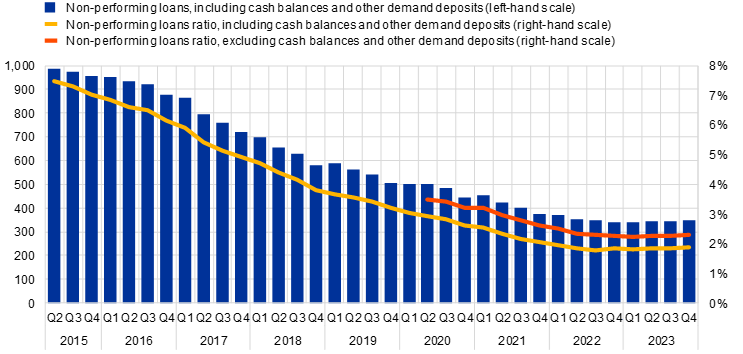
Source: ECB.
Chart 5
Non-performing loans by counterparty sector
(EUR billions; percentages)
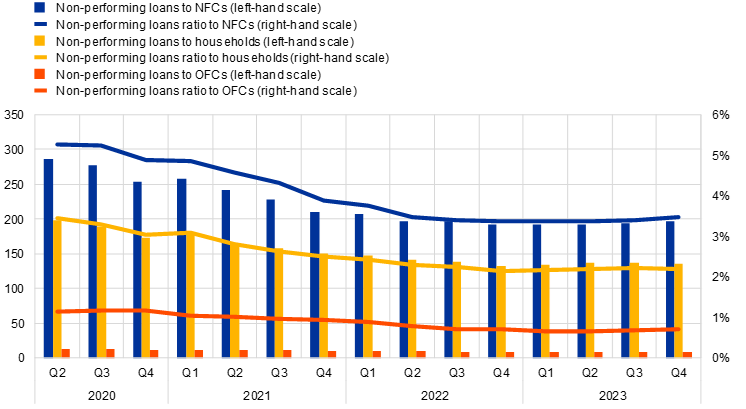
Source: ECB.
Note: “NFCs” stands for “non-financial corporations”. “OFCs” stands for “other financial corporations”.
Chart 6
Cost of risk
(percentages)
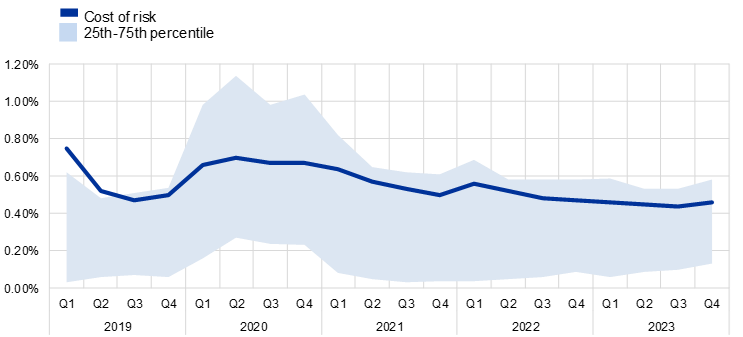
Source: ECB.
Chart 7
Loans and advances subject to impairment review
(EUR billions; percentages)
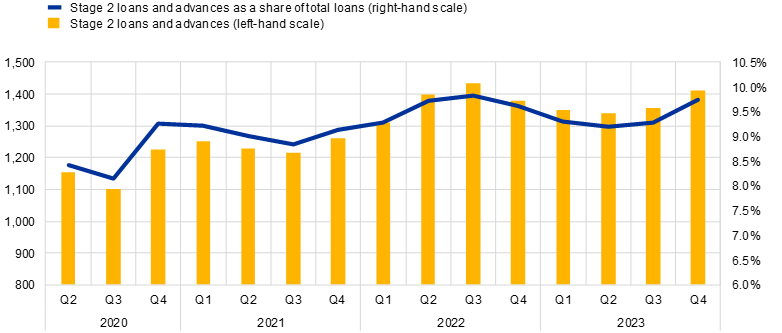
Source: ECB.
Note: Stage 2 includes assets that have shown a significant increase in credit risk since initial recognition.
Return on equity
The aggregated annualised return on equity stood at 9.31% in the fourth quarter of 2023 (compared with 7.68% in the fourth quarter of 2022). A sizeable increase in operating income (driven by higher net interest income, which rose by 20% year on year) was the main contributor to the increase in aggregate net profit (the numerator of the return on equity).
In the fourth quarter of 2023, the net interest margin increased further to 1.60% (compared with 1.36% one year ago), while showing structural differences across countries. This ratio ranged from 0.91% in France to 3.74% in Latvia.
Chart 8
Return on equity and composition of net profit and loss
(EUR billions; percentages)
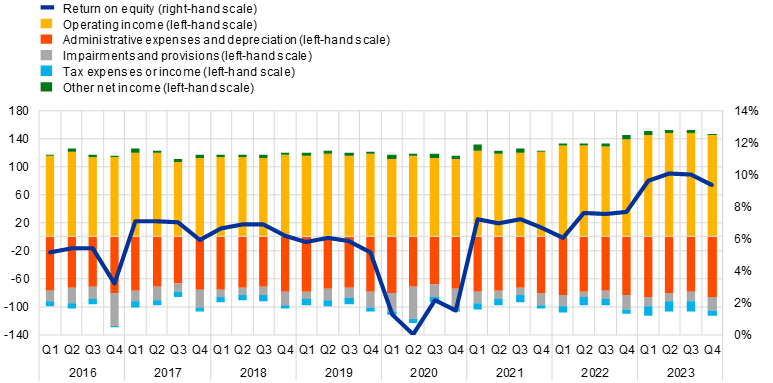
Source: ECB.
Chart 9
Net interest margin by country for the fourth quarter of 2023
(percentages)
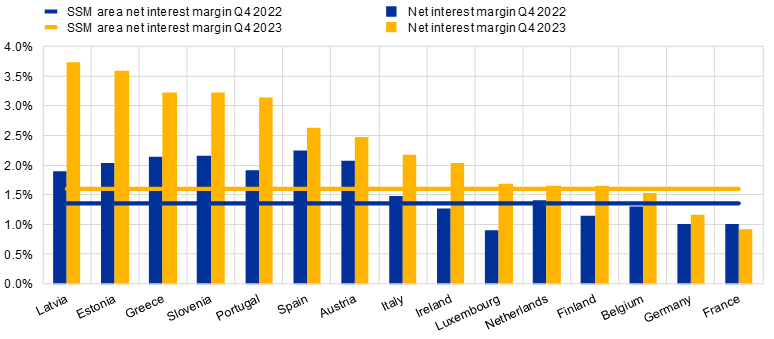
Source: ECB.
Notes: “SSM” stands for “Single Supervisory Mechanism”. Some countries participating in European banking supervision are not included in this chart, either for confidentiality reasons or because there are no significant institutions at the highest level of consolidation in that country.
Factors affecting changes
Supervisory banking statistics are calculated by aggregating the data that are reported by banks which report COREP (capital adequacy information) and FINREP (financial information) data at the relevant point in time. Consequently, changes from one quarter to the next can be influenced by the following factors:
- changes in the sample of reporting institutions;
- mergers and acquisitions;
- reclassifications (e.g. portfolio shifts as a result of certain assets being reclassified from one accounting portfolio to another).
For media queries, please contact Nicos Keranis, tel.: +49 172 758 7237.
Notes
- The complete set of Supervisory banking statistics with additional quantitative risk indicators is available on the ECB’s banking supervision website.
European Central Bank
Directorate General Communications
- Sonnemannstrasse 20
- 60314 Frankfurt am Main, Germany
- +49 69 1344 7455
- media@ecb.europa.eu
Reproduction is permitted provided that the source is acknowledged.
Media contacts

